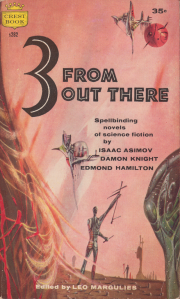The Book: The Weapon Shops of Isher by A.E. Van Vogt. Copyright 1951, printed in 1961 by Ace books, D-482.
The Setting: Earth, 1951 and 4784.
The Story: The Weapon Shops sell guns. Guns which cannot be used against others, except in self defense. The government of Isher wants to destroy the shops. Things get a little timey-wimey. Also, a boy doesn’t want to go into the family business, goes to the big city, and gets in some deep trouble.
The Science: Clarke’s third law states that “Any sufficiently advanced technology is indistinguishable from magic.” This is the case with the Weapon shops. Their existence, their infrastructure, and their guns are all basically indistinguishable from magic. Apparently, the founder of the shops was a super genius who figured out how to imbue objects with the ability to determine the intent of an individual when an individual touches them. Magic. The rest of the Isher-world has to get by with corruption and not-a-little-bit of seediness.
The Reaction: Here’s another book I had a good time reading. I would stay up late just to read some more. There are a lot of points of view, and a few jarring moments, not to mention, the author seems to have a man-crush on one of his characters. But it was fun.
The Cover: Cover art by Harry Barton. Boy howdy, do I love this cover. Two guys in jeans and t-shirts are fighting in front of some super-neat device (a ray gun of some kind?), against a future-city backdrop. There’s so much energy in this cover. And you know the guns are from the future because they have those three little rings around the muzzle. And did I mention they’re wearing jeans and t-shirts? So awesome.
Etc: According to wikipedia, this book apparently is a bringing together of three stories from the same universe –
“The Seesaw” (Analog Science Fiction and Fact, July 1941)
“The Weapon Shop” (Analog Science Fiction and Fact, December 1942)
“The Weapon Shops of Isher” (Wonder Stories, February 1949)
This explains some of the slight jarring I felt while reading, but they are sewn together pretty darn well.









